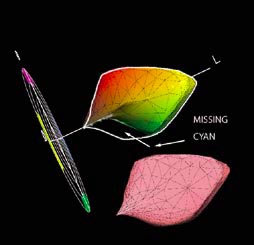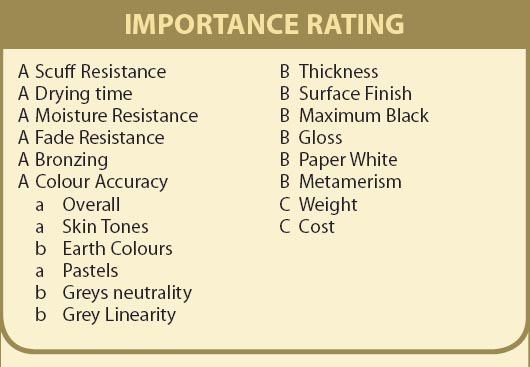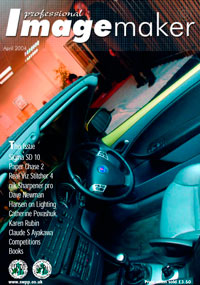articles/Paper/layingtrail-page1
Paper Chase - Laying the Trail - part 1 of 1 2 3 4 5 6 7 8 9 10
by Mike McNamee Published 01/04/2004

The damaged profile. Note the "bite" out of the gamut in the cyan part of the spectrum.
In your Editor's previous life with 'Digital Photographer magazine' one of the most successful features was one on inkjet art papers. Indeed requests are still made for copies of it. That was three years ago and so it is timely for Professional Imagemaker to take a look at the subject of paper and all that goes with it (and on it!).
Many things have changed in the 3-year intervening period. For one thing usage has risen dramatically. In 2000, 65 billion sheets of inkjet paper were sold; this is predicted to rise to 97 billion sheets in 2005 - so much for the paperless society. Pigment dyes are now more common and their gamut and quality have improved to the extent that they provide formidable opposition to their dye-based cousins in terms of colour quality. Along with the change to pigment has come longer lifetimes in terms of fade resistance. We are not presently going to consider dye-based inks in the same depth as pigment as we are wary of considering them a suitable medium for prints that are to be sold to clients - time may change this perception, we'll let you know!

The other thing is that this is a paper test, not an ink or printer test. We have to limit the number of options for our tests and have fixed upon the Epson 2100 and the Epson 7600 using either Matte Black or Photo Black ink as appropriate. In terms of providers, Epson has risen to a position of dominance in the printer-manufacturing sector and continues to strengthen. Although papermaking is many centuries old there have been a number of advances in the way it is prepared for inkjet use. Resin coatings have been migrated from the silver image materials to inkjet papers, thus saving the bacon of companies such as Ilford, who are now the largest inkjet paper maker in the world. Traditional art paper makers such as St Cuthbert's Mill have developed inkjet products by marrying their substrate skills to the coating skills of others such as Kentmere. Ink formulations have to be matched closely to the paper coating type or problems of smearing and non-drying can occur; ink penetration has to be optimised and keeping ozone out is a priority. One of the complications of testing and examining papers is knowing just what you are dealing with. A couple of hours on the Net unearthed more than 50 inkjet paper brands, excluding own name brands such as PC World. However bear in mind that there are only 5 or 6 mills in the world and they all make and use each other's technology - the name on the box is not the name of the mill! A a conservative estimate of each brand having 5 papers, gives us 200 papers to look at or almost 1000 prints to make. Epson though have about 30 papers, Permajet have about 15 - so these figures are probably an underestimate of the task ahead!
You are currently on page 1
- Paper Chase - Laying the Trail page 1
- Paper Chase - Laying the Trail page 2
- Paper Chase - Laying the Trail page 3
- Paper Chase - Laying the Trail page 4
- Paper Chase - Laying the Trail page 5
- Paper Chase - Laying the Trail page 6
- Paper Chase - Laying the Trail page 7
- Paper Chase - Laying the Trail page 8
- Paper Chase - Laying the Trail page 9
- Paper Chase - Laying the Trail page 10
1st Published 01/04/2004
last update 09/12/2022 14:55:39
More Paper Articles
There are 0 days to get ready for The Society of Photographers Convention and Trade Show at The Novotel London West, Hammersmith ...
which starts on Wednesday 15th January 2025





